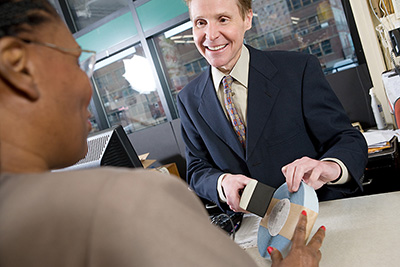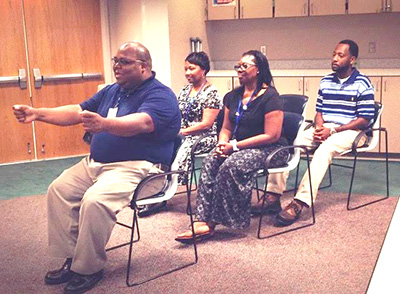Though I rarely do traditional classroom work now, I’m still around it all the time, as it’s what my co-workers do all day, every day. Our halls are full of people here to attend classes. I hear them before sessions and during breaks, talking to one another or on phones calling home or back to the office. Often they are enjoying the class they’re in. And often they complain that the sessions are good, but not quite realistic, or not always relevant to their needs. In the classroom, a good trainer can adjust on the fly, a luxury not available to the eLearning designer. Here are some common issues and ideas for overcoming them.
Talk to the workers
My husband, Kent, works for the US Postal Service. Once during the winter holiday rush, as lines got longer and tempers grew shorter, he was pulled out to help on the front line for a bit. Just as he stepped up, someone from management saw the date—near the end of the year—and realized Kent needed to complete some mandatory customer service training ASAP. So he gets pulled from the line to … sit in a back room, alone, and watch a customer service video. He has seen a number of these videos before and says they’re all amazing: All the customer service training materials show articulate, well-dressed, perfectly groomed people who all, miraculously, have exact change.

Figure 1: Customer service training materials
So Kent watches the video, signs something attesting to same, and then heads back out to the main floor. There, he is met by a longer line of customers, now angrier than they were when he left. His first customer? More or less the guy in Figure 2.

Figure 2: Customer service reality (Source: YouTube user FalseFrontsFX)
A couple things here:
- There is a complete disconnect between the learner’s daily life and the one depicted in training scenarios. Perhaps they are too pristine and “clean.” Or perhaps resolution is achieved in practice much more easily and neatly than it ever will be in real life. How can you get better information to help you with more realistic examples and problems? What would make your work more credible to the end users?
- There’s no such thing as fidelity. I’m sure the people who paid for it, developed it, and deployed it never intended for that video to be shown at the last minute under such duress. The very setup adversely affected the customers that Kent was trying to serve. But that kind of thing happens all the time. What do you know about how training will be deployed? How can you influence conversations about that?
What happens in the classroom is sometimes worth knowing
For years I’ve been writing about the dangers of trying to “convert” classroom training to online, as it is so often nothing more than an upload of slides and other static materials, often even without notes. I suggest instead thinking of it as “transforming” by trying to capture what a good instructor brings to that experience. It’s hard to do that if you’re just going by input from SMEs (subject matter experts) and supervisors, or from reviewing materials and lesson plans that may not tell the whole story. Try to sit in on some classes and see what’s really going on.
For example: I work for state government. As we are taxpayer-funded, we do a lot of work around customer service skills. There are pretty standard means of providing classroom training. When you’re tasked with creating something for online delivery, you do due diligence and talk with stakeholders. It’s often decided that the training will focus on basic skills like making eye contact, matching the customer’s energy, and sitting or standing to make eye contact. What the stakeholders likely don’t mention are the few but important outliers. Consider our county van drivers, the ones who do things like drive senior citizens to medical appointments. They typically fall under a broader category like “operations” or “transportation,” so they are enrolled in the same general training as other staff.
Compared to other service providers, a van driver’s situation is unique in a few ways:
- The driver always has his or her back to the customer
- The driver makes eye contact through quick glances in a mirror
- If there’s a problem, the driver has to get the van off the road, to a safe spot, and notify a dispatcher about the issue
When a van driver turns up in our face-to-face sessions, the classroom trainers will adapt the usual activities to give this participant some realistic practice. Figure 3 shows what happens in the traditional classroom.

Figure 3: A van driver has unique constraints when delivering quality customer service
It’s the kind of thing that all the trainers know but that probably isn’t documented anywhere. Sitting in on a few classes might give you some insight into unusual circumstances or off-the-cuff accommodations. Transforming this content might mean a few extra screens or a short separate module, but recognition of unique worker needs would shore up a course’s credibility—and effectiveness.
So: Try to get access to the workers who actually do the work. Ask to look at things like internal discussion forums or status reports. Talk to HR about accident reports, or trends in worker grievances, or performance review data in the aggregate. Try to get specifics about the target audience. Are there any unique situations, like the van drivers’? And finally, work with stakeholders to draft and communicate a plan for deploying programs as they’re intended. There will always be issues with fidelity, but perhaps you can help influence implementation in ways that, at the very least, won’t make problems worse.
When you’re looking at “converting” classroom training to an online format, try to actually get to the classroom event. Get clear on what really goes on there, as opposed to what you might hear in a meeting or via document review. Talk to the trainers or facilitators who run classroom events, and ask them about any tricks or special adaptations they might employ. Then work on ways to bring the richness—and maybe even fun—to the worker’s online experience.


